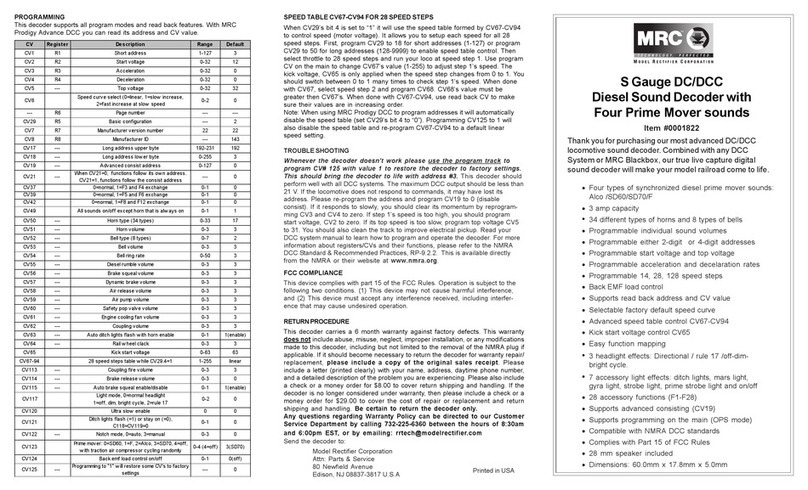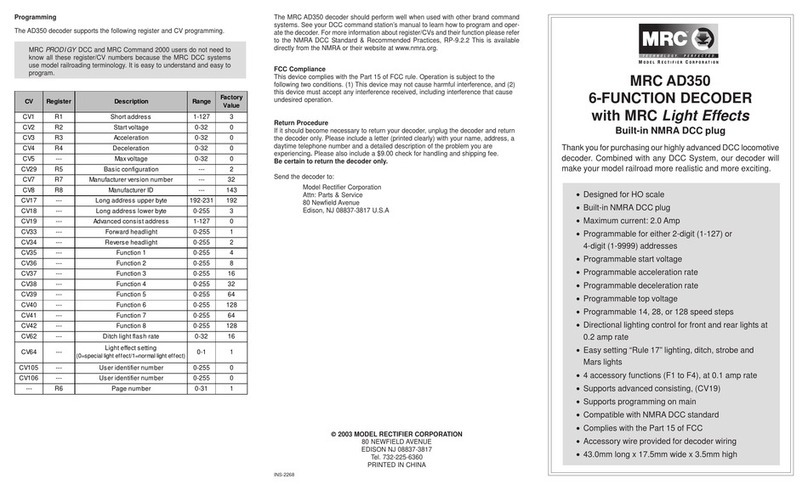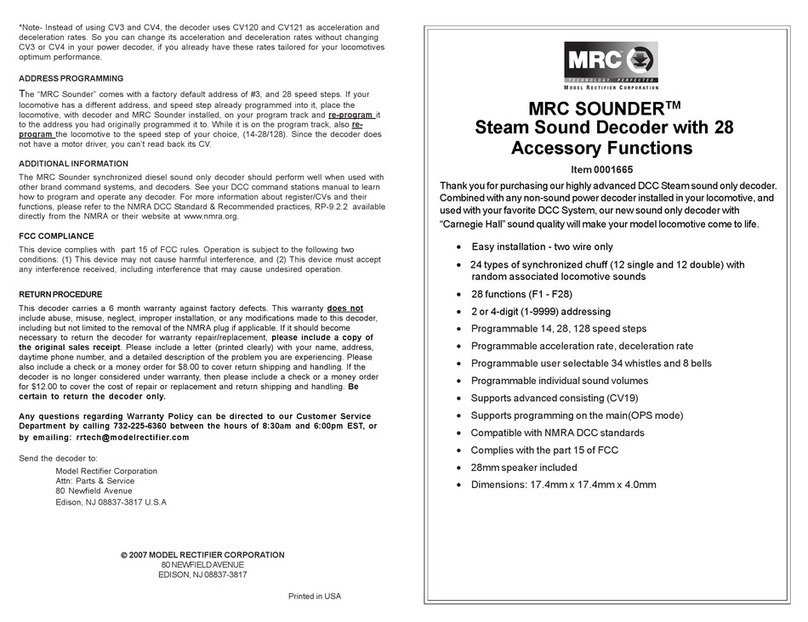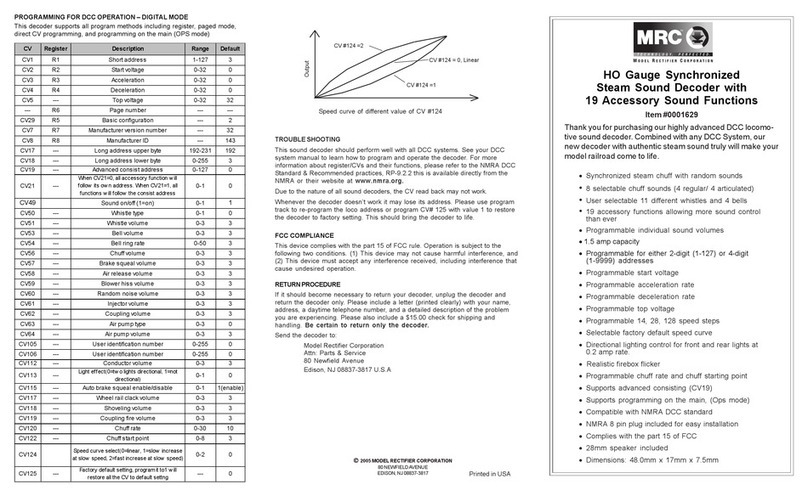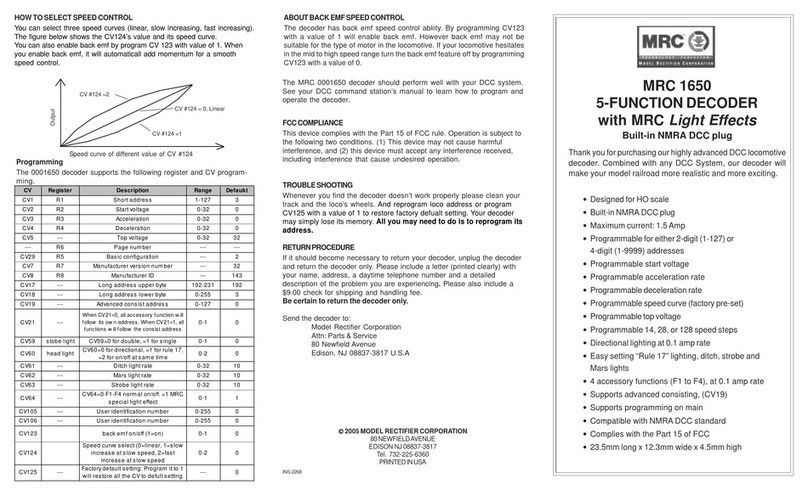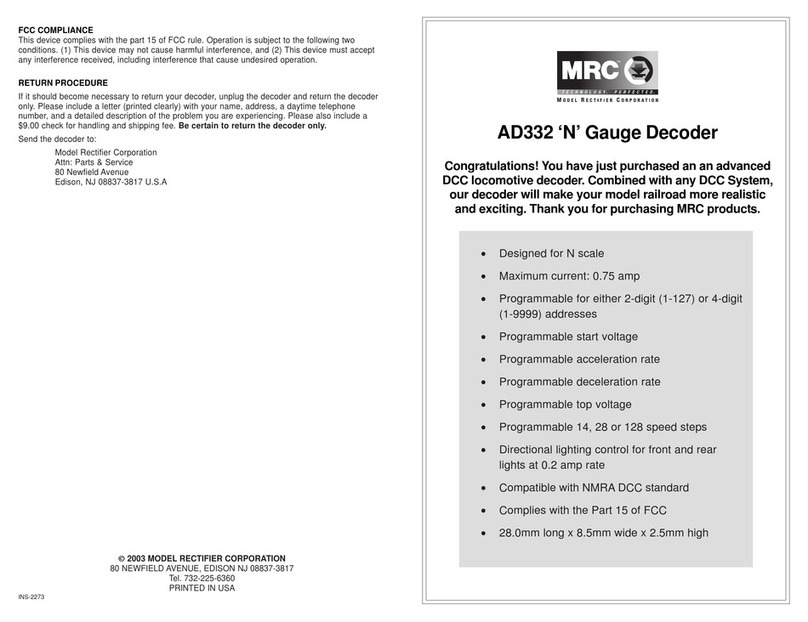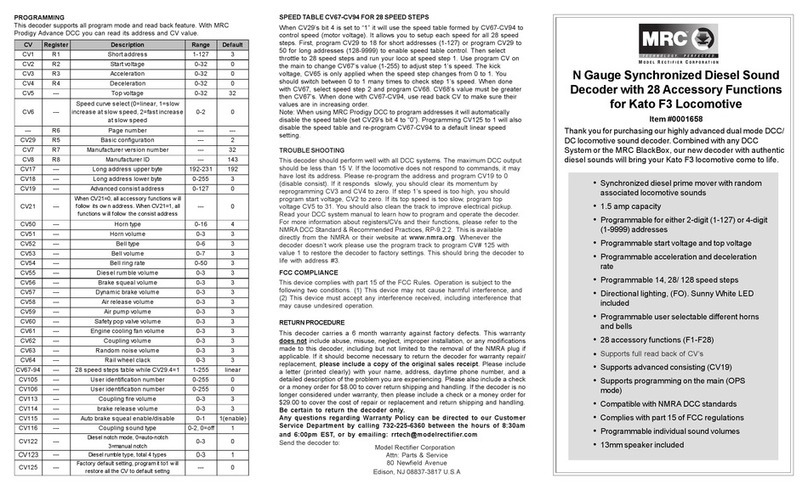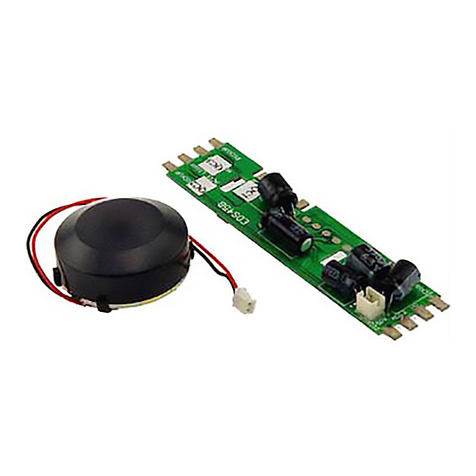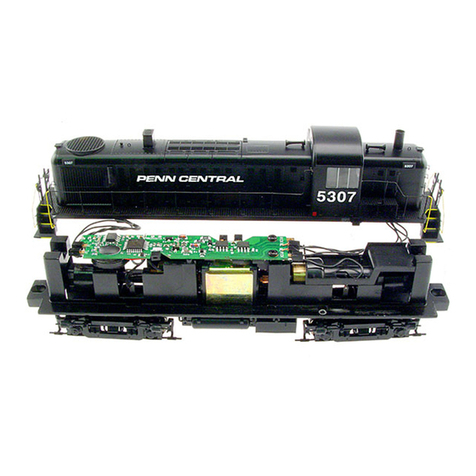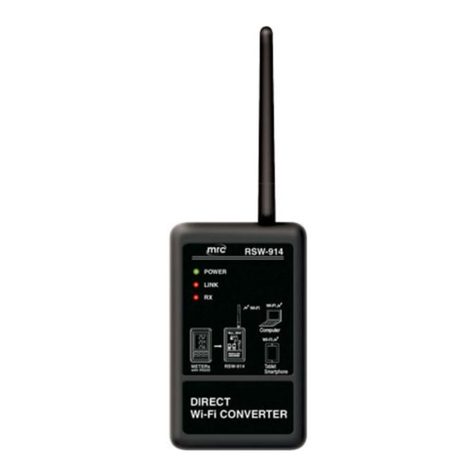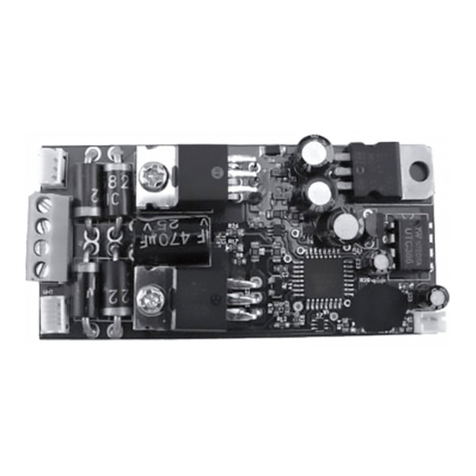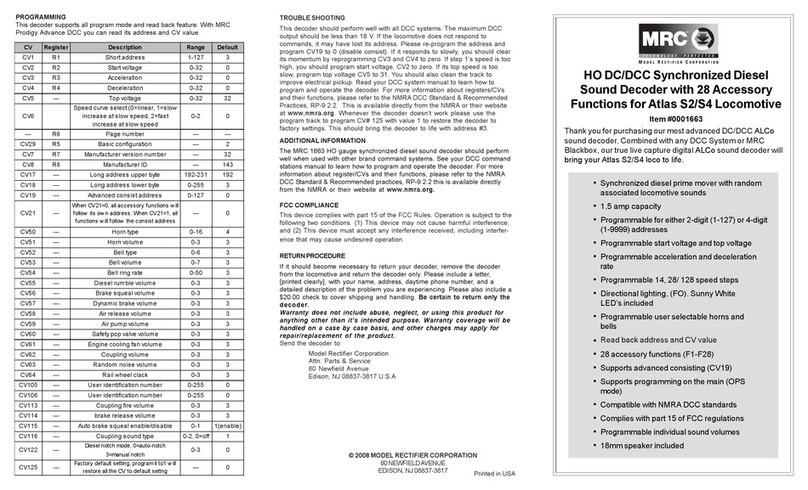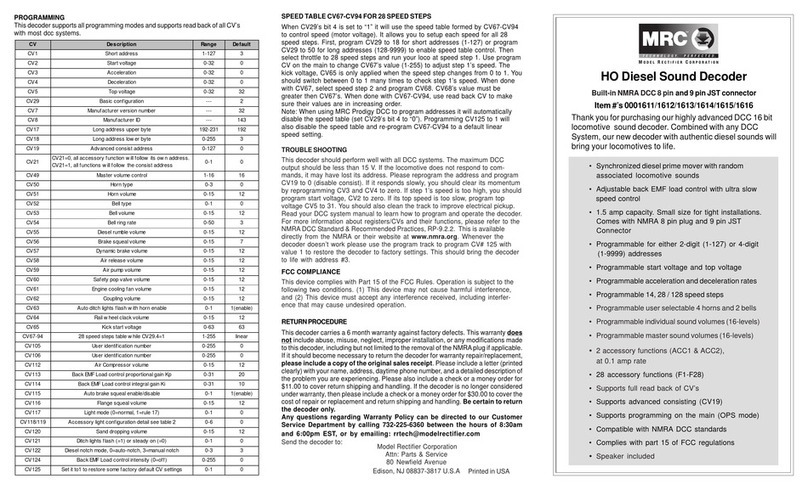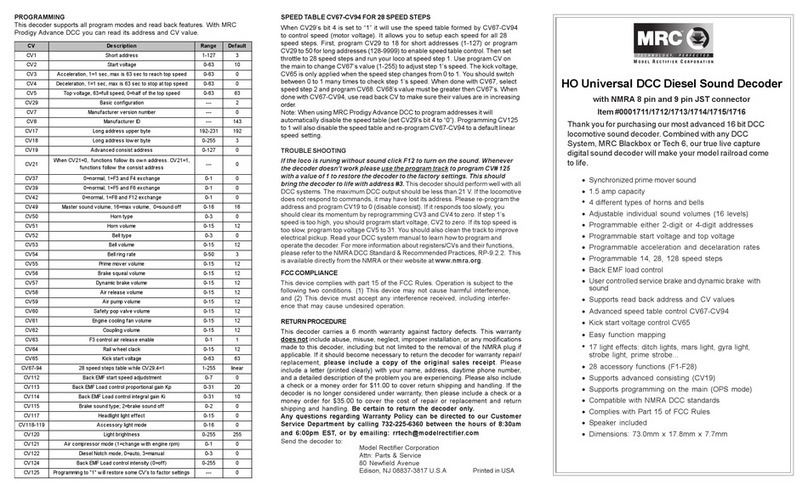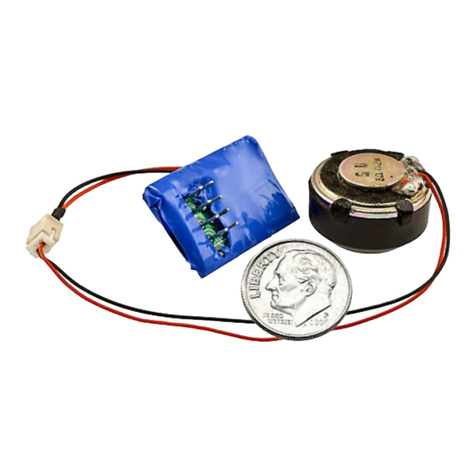
INSTALLATION
If your loco has a 9 pin JST plug or NMRA 8 pin socket, you can simply unplug the
orignal connector and plug in the decoder. If not, you have to remove the circuit
board and hard wire in the decoder. The decoder will be inserted between the wheel
pickups and the motor. After disconnecting the motor terminals from the pickups,
connect the right side pickup wires to the red decoder wire, and connect the left side
pickup wires to the black wire. Connect the right motor terminal to the orange wire,
then connect the left motor terminal to the grey wire. The motor terminals must be
isolated from the wheel pickups. The white wire is for the front headlight and the
yellow wire is for the rear light. The blue wire is the light common, or if using LED’s,
the blue wire is LED positive. The green wire (ACC1) and brown wire (ACC2) are for
your accessory lights. Use good soldering techniques, and use shrink wrap to
isolate the connections. The decoder can’t touch any metal part or bare wires.
You can use 8 Ohm speakers sizes from 18mm to 28mm. The larger speaker the
better the sound quality.
If you use 1.5V bulbs or LED’s, you should connect a 1k ohm resistor in series to
one of the leads to reduce the voltage. Also use CV120 to adjust the brightness.
OPERATION
The decoder has a default address #3. Select address #3 on your DCC. Release
service brake (F5) and dynamic brake (F6). You will hear the brake release
sound when you turn off F5. Move up the throttle and the loco should start to
move. If the loco does not move a speed 1 you can add more start voltage by
programming CV2 with a large number. You can program the acceleration
momentum CV3 and deceleration momentum CV4 to simulate the real train. The
decoder has start up and shut down features. If the loco was previously shut
down you have to start up the engine first. Press any function key to start up the
engine. To shut down the engine you must bring the loco to idle and then press
F8 three times.
The decoder has six types of diesel rumble. You can program CV123 to select
the diesel rumbles to match your model. It has 22 different horns and 8 bells. You
can use F19 or program CV50 to select horn. And use F18 or program CV52 to
select bell.
This decoder has an easy function exchange feature (re-mapping) that allows
certain pairs of functions to be swapped. For example, program CV37 with a
value of 1 will make F3 and F4 exchanged.
The decoder default is set to automatic notch mode. You can program CV122 to
3 for manual notch mode for realistic operation. In the manual notch mode the
notch level is not controlled by loco speed. It is controlled by F9 ( notch up) and
F8 ( notch down).
To make air compressor’s speed synchronize to the prime mover, program
CV121 with a value of 1. For a constant speed program CV121 with a value of
0.
SERVICE BRAKING
To apply service brake set throttle to zero and press F5. The loco will slow down
fast and you will hear the brake squeal. You can pump the brake by turning F5
on and off to stop the loco at desired location. The brake rate is proportional to
deceleration rate that you program in CV4. If you forget to turn off F5 and move
the throttle up. The loco will move. However, when you release the throttle the
service brake will apply again. The service brake can only operate when throttle
is at 0. If you don’t hear the brake sound program CV115 with a value of 2.
DYNAMIC BRAKING
You can use dynamic brake F6 to reduce the speed. When you turn on F6 the
prime mover will notch down to 1 and you will hear the dynamic brake sound and
the loco will reduce its speed. When you release F6 the loco will speed up to the
orignal speed. If you forget to turn off F6 and move throttle up it will automatically
disable the dynamic brake and loco will start to move. To apply dynamic brake
again you have to cycle F6 off and on.
BACK EMF LOAD CONTROL (PID CONTROLLER)
This decoder is equipped with adjustable back EMF load control feature. It is a
closed loop speed control. With back EMF load control the locomotive will maintain its
speed regardless of pulling up hill or driving down hill. You may program the back EMF
load control intensity, CV124, to a lower value to get less back EMF load control. This
will enable the locomotive to slow down during uphill travel like a real locomotive.
The PID controller contains three components: proportional gain (CV113); the
integral gain (CV114); and derivative gain (fixed). Designing (tuning) a PID
controller is a kind of “rocket science”. So we optimized these gains at the factory
but still give the customer final adjustments. We recommend that you do not change
these settings. Too much gain may cause the motor to oscilate (become unstable).
Too little gain may cause a slow response. Additional knowledge of PID feedback
control is required before attempting to adjust CV113 and CV114. If CV113 and CV114
are programmed incorrectly, the locomotive will not run smoothly. Program CV125 to
“1” will automatically restore the default PID controller settings. If you can not get the
PID controller work properly or you don’t know to tune it you should turn off the Back
EMF load control by program CV124 with a value of 0.
LIGHT EFFECT PROGRAMMING CHART FOR CV#117/118/119
The decoder has 17 different lights effects. CV 117 controls both front and rear
headlight effect. Use F0 to turn on or off the Headlights. CV118/CV119 control
ACC1/ACC2 light effect. Use F3 to turn on or off ACC1 and ACC2. For ditch light
operation you must program Cv118 and CV119 to the same ditch light type. In type
A the ditch lights will flash when F2 (horn) or F3 is on. In type B the ditch lights
will flash when F2 is on and stay on when F3 is on. If you use a value inconsistent
with actual headlights, ( CV117), the headlights will default to normal on/off. For
example trying to use a value of 14 in CV117 for firebox flicker, the headlights
will default to normal on/off.
Light effect chart
Wiring diagram
black
white
left
orange
gray
Motor
blue
red
yellow
rear light
front light
green
right
brown
ACC1 light
ACC2 light
CV123 Prime mover
SD39, SD40, SD40A, SD40-2, SD40T-2, SD45. SDP45, SD45X, SD45-2,
SD45T-2, F45, FP45, DDA40X, GP15T, GP39, GP39-2, GP40, GP40-2
SW1000, SW1001, SW1500, SW1504, MP15DC, MP15AC, MP15T,
GP38, GP38-2, SD38, SD38-2, GP15AC, GP15-1
2 EMD710 SD70AC, SD70M-2
3 ALCO 244
4 ALCO 539T
F2A/B, F3A/B, F7A/B, F9A/B, BL1, BL2, FP7, FL9, FT, GP7, GP9, GP18,
GP28, E6, E7, E8, E9, NW2, NW3, NW4, SW1, SW7, SW8, SW9, SW600,
SW900, SW1200
5 EMD567
0 EMD645E
1 EMD645
Suitable for the locomotive
RS-3, PA1, PB1
S-2, S-4, RS-1, RSC-1, RSD-1, DL-105, DL107, DL-108, DL-109, DL-110
CV117/118/119 Light effect
0 Normal on/off
1 Dynamo effect (fading)
2 Dim , bright, off cycle
3 Rule 17
4 Both headlights on
5 Ditch Light type A
6Ditch Light type B
7 Gyralite
8 Mars Light
9 Prim e strato light
10 Single strobe light
11 Double strobe light
12 Rotating beacon
13 Fred Rear End Flashing
14 Firebox Flicker A
15 Firebox Flicker B
16 Engine Exhaust Flicker
Function Idle/Moving
F0 Headlight on/off
F1 Bell on/off
F2 Horn
F3 Air release
F4 Coupling
F5 Service brake: brake when moving, brake release when idle
F6 Dynamic brake on/off. The loco will slow down when F6 is on
F7 Air hose firing/uncoupling lever
F8 3 times will shut down when in idle / Notch down when in manual notch
F9 Engine cooling fan / Notch up when in manual notch
F10 Rail wheel clack (only moving)
F11 Traction air compressor
F12 Toggle between max master volume and sound off (CV49)
F13 Reduce master volume by 1 / air release when reach minimum
F14 Increase master volume by 1 / air release when reach maximum
F15 Air compressor on/off
F16 Flange squeal
F17 Air release
F18 Change bell type CV52 (use F1 to turn off bell after adjustment)
F19 Change horn type CV50
F20 Associated loco sound
F21 Increase bell volume CV53 by 1. It will roll back to 0 when reach 15
F22 Increase horn volume CV51 by 1. It will roll back to 0 when reach 15
F23 Increase diesel volume CV55 by 1. It will roll back to 0 when reach 15
F24 Safety valve pop
F25 Air release
F26 Flange noise
F27 Sand drop
F28 Air compressor speed mode change (CV 121) / with Air release














